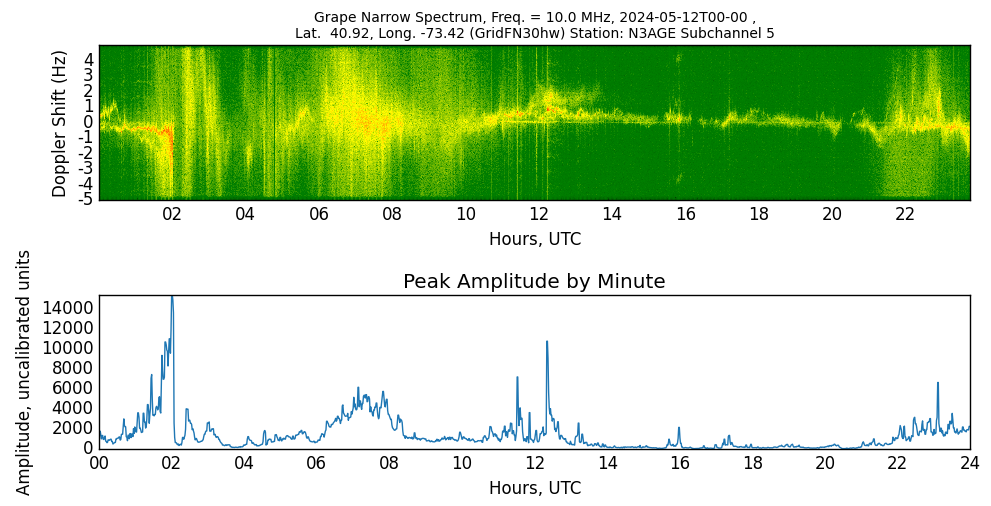WSPRDaemon GRAPE - Overview, Specifications, Sourcing
|
|
 |
Overview
The WPSRDaemon GRAPE is the most sophisticated component of the HamSCI Personal Space Weather Station (PSWS). It is a wide bandwidth SDR (software defined radio) system capable of receiving the entire MF and HF bands, converting radio signals into high speed digital data streams. It is able to measure Doppler shift while receiving multiple standard frequency stations (eg WWV/H on five frequencies and CHU on three frequencies - simultaneously). Further, it can decode WSPR/FST4w digital mode signals. All data is uploaded to HamSCI data servers for later research and analysis.
The PSWS project involves monitoring changes in the Earth's ionosphere via receiving, decoding, digitizing and archiving precision radio signals on a 24/7/365 basis. A sample plot from May 12, 2024 (a few days after a major solar storm, note the unsettled, Doppler shifted frequency measurement of station WWV) appears above.
Specifications
| Purpose | Wide spectrum receiving system, reports data in multiple formats: WSPR/FST4w and Doppler shift monitoring in the DRF format. Data is useful for studying behavior of the ionosphere. |
| Receiver | RX-888 Software Defined Radio, as modified per instructions below |
| Bandwidth | 0.5 through 60 MHz (varies according to software configuration) |
| Frequency Stability | As stable as the Leo Bodnar GPS disciplined oscillator, approaching 1x10-12 |
| Recommended Computer | Beelink Mini PC, AMD Ryzen 7 processor (2 GHz/8 cores), 16 GB memory, 500 GB SSD |
| Operating System | Ubuntu |
| Required software | KA9Q Radio, Ubuntu Server (version TLS 24.04) (subject to future revisions) |
| Data Repository | The WSPRDaemon GRAPE data is freely accessible, available for viewing, plotting and downloading from the Personal Space Weather Station Central Control System (self-created user account required). |
Sourcing
DIY Option: At present, the WSPRDaemon GRAPE RX-888 GPS disciplined receiving system is a DIY (do it yourself) project, requiring the following steps: 1) Obtain hardware 2) Modify the RX-888 per the clock kit 3) Load operating system and install KA9Q radio from GitHub (requires working knowledge of compiling the 'C' language, Linux administration) 4) Deploy antennas (GPS and MF/HF), connect filter, preamp, etc.
- RX888 SDR (amazon.com) (There are sometimes other on-line vendors at lower prices, be sure the vendor you choose is reputable before ordering)
- Beelink Mini PC, (amazon.com)
- Bodnar GPS Disciplined Oscillator, model LBE-1420 (leobodnar.com)
- Low pass filter and preamplifier (turnislandsystems.com)
- RX-888 Clock and Thermal Pad Kit (TAPR.org)
- Software...Ubuntu Server 24.04 TLS
- Software...WSPRDaemon
- Software....KA9Q radio (also see Tom McDermott's YouTube series, Getting Started with KA9Q radio (the link is to Part 1, look for Parts 2 through 5 on YouTube)
- Antenna recommendation - under development
- Instructions - under development
HamSCI Provided: HamSCI has been awarded a grant from the National Science Foundation to fund up to thirty (30) complete PSWS (WSPRDaemon GRAPE + VLF Receiver + Ground Magnetometer). In 2025, HamSCI be will selecting locations based on an application review process, with a goal of siting thirty systems at scientifically advantageous locations across North America. If you are interested in being considered as a PSWS host, please navigate to the Searching for Instrumentation Sites page, review the site selection criteria, and if you feel you qualify, complete the Interested Participant Form at the bottom of the page. There's also a button to submit questions to the project team. The actual ship date for the first complete PSWS is yet to be determined...if all goes well, mid to late 2025.
Further Information
- Support is best obtained by checking in to one of the TAPR-HamSCI Technical Sessions on Zoom. All are welcome to join, in ask questions, assist others. The Zoom link can be found on the HamSCI Get Involved page.
- HamSCI explains The Science Behind the GRAPE Doppler Monitor
- The WSPRDaemon GRAPE is just one module of the HamSCI Personal Space Weather Station (PSWS) Learn more about the PSWS project here: Overview of the Personal Space Weather Station (PSWS)
Credits
The original concept for the WSPRDaemon-GRAPE is credited to Rob Robinett, AI6VN, who is also the developer of the WSPRDaemon software package and website. HamSCI recognizes Phil Karn, KA9Q, for his efforts in writing the KA9Q Radio software package, enabling the RX-888 (and other SDRs) to perform accurate and reliable data collection. HamSCI owes a debt of thanks to TAPR, an organization of amateur (ham) radio operators dedicated to advancing the state of the radio art, for helping bring the WSPR Daemon GRAPE from concept to reality. Dr. Nathaniel Frissell, W2NAF, was the Principal Investigator on National Science Foundation grant 2002278 ('Collaborative Research DASI Track 1 - Personal Space Weather Station'). Their efforts were supported by additional NSF grants (1922972, 1932997) and these institutions:


